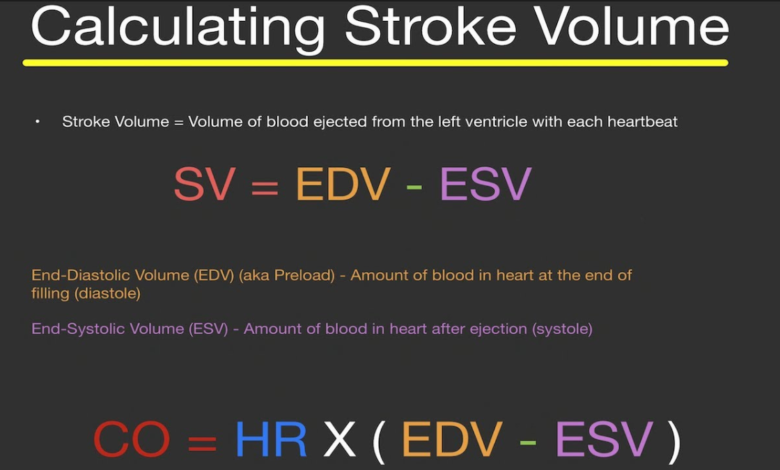Understanding the Stroke Volume Equation: A Key to Cardiovascular Health

At the heart of human health lies a crucial concept—the stroke volume equation. This formula helps determine the amount of blood the heart pumps with each beat, making it a fundamental aspect of understanding how well the cardiovascular system functions. Stroke volume directly impacts athletic performance, heart health, and overall well-being.
In this article, we’ll dive into the mechanics of the stroke volume equation, explore how it works, and discuss why it’s essential for maintaining a healthy heart. We’ll also look at how various factors, such as exercise and medical conditions, affect stroke volume and what it means for daily life. Whether you’re a fitness enthusiast, a student, or just curious ThreeBoystime about heart health, understanding the stroke volume equation can empower you to make smarter lifestyle choices.
What Is Stroke Volume?

Before jumping into the stroke volume equation, let’s first understand what stroke volume means. Stroke volume refers to the amount of blood pumped out of the left ventricle of the heart with each beat.
The heart contracts to push oxygen-rich blood into the arteries, ensuring the body gets the oxygen and nutrients it needs. On average, a healthy adult’s heart pumps 70 milliliters of blood per beat. However, stroke volume can vary based on factors like age, fitness level, and health conditions.
The Stroke Volume Equation Explained
The stroke volume equation is used to calculate how much blood is pumped by the heart per beat. This equation takes into account two essential factors:
Stroke Volume (SV) = End-Diastolic Volume (EDV) – End-Systolic Volume (ESV)
- End-Diastolic Volume (EDV): This is the amount of blood in the heart’s ventricles at the end of the relaxation phase (diastole).
- End-Systolic Volume (ESV): This is the amount of blood left in the ventricles after the heart contracts (systole).
Essentially, stroke volume is the difference between the amount of blood that fills the heart and what’s left after it pumps.
Factors Affecting Stroke Volume
Several factors influence the values in the stroke volume equation. A change in any of these variables can alter how efficiently the heart works. Let’s take a closer look at the main factors:
Heart Rate
The faster the heart beats, the less time the ventricles have to fill with blood, which can decrease stroke volume. Athletes with slower resting heart rates often have higher stroke volumes because their hearts pump more efficiently.
Preload
Preload refers to the amount of blood returning to the heart before it contracts. The higher the preload, the more the ventricles stretch, increasing stroke volume. This is known as the Frank-Starling mechanism, where more blood leads to stronger heart contractions.
Afterload
Afterload is the resistance the heart has to overcome to pump blood. High afterload (like high blood pressure) makes it harder for the heart to pump blood, reducing stroke volume.
Contractility
Contractility refers to the strength of the heart’s contractions. Stronger contractions result in higher stroke volume, while weaker contractions can lower it.
Importance of the Stroke Volume Equation in Health
The stroke volume equation plays a crucial role in monitoring heart health. Doctors, athletes, and trainers use this equation to assess how efficiently the heart is pumping and identify any underlying issues.
- Heart Health Monitoring: Low stroke volume could indicate heart disease, valve problems, or other cardiovascular issues.
- Fitness Assessment: Athletes with higher stroke volumes tend to have greater endurance and cardiovascular efficiency.
- Treatment Planning: For patients with heart conditions, understanding stroke volume helps doctors tailor treatments to improve heart function.
How Exercise Affects Stroke Volume
Exercise has a significant impact on the stroke volume equation. During physical activity, the body demands more oxygen, and the heart works harder to supply it. Here’s how exercise influences stroke volume:
- Increased Preload: Exercise boosts blood return to the heart, increasing stroke volume.
- Enhanced Contractility: Regular exercise strengthens heart muscles, allowing for more powerful contractions.
- Lower Resting Heart Rate: Over time, the heart becomes more efficient, resulting in a higher stroke volume at rest.
Endurance athletes, such as marathon runners, often have larger stroke volumes because their hearts adapt to long-term training.
Stroke Volume vs. Cardiac Output
While stroke volume is the amount of blood pumped per beat, cardiac output measures the total amount of blood pumped per minute.
The formula for cardiac output is:
Cardiac Output = Stroke Volume × Heart Rate
This relationship shows that both heart rate and stroke volume contribute to overall heart performance. When stroke volume decreases, the heart may compensate by increasing the heart rate to maintain cardiac output.
Medical Conditions That Affect Stroke Volume
Several health conditions can impact the stroke volume equation by altering EDV, ESV, or both.
ConditionImpact on Stroke Volume
Hypertension Increases afterload, reducing stroke volume
Heart Failure Weakens contractility, lowering stroke volume
Valve Disorders Affect blood flow, disrupting stroke volume
Dehydration Decreases preload, lowering stroke volume
Arrhythmia Irregular heartbeats reduce filling time and output
Monitoring stroke volume in patients with these conditions helps doctors adjust treatments and track progress.
Tips to Improve Stroke Volume Naturally
Improving stroke volume involves promoting heart health and cardiovascular fitness. Here are some tips to help boost your heart’s performance:
- Engage in Aerobic Exercise: Activities like running, swimming, or cycling improve heart function over time.
- Stay Hydrated: Proper hydration ensures enough blood volume to fill the heart effectively.
- Manage Stress Levels: Chronic stress can increase afterload, making it harder for the heart to pump efficiently.
- Maintain a Balanced Diet: Foods rich in potassium, magnesium, and omega-3s support heart health.
- Monitor Blood Pressure: Keeping blood pressure under control reduces afterload and promotes better stroke volume.
Future Research and Innovations in Cardiovascular Health
Scientists and medical professionals continue to explore ways to optimize heart function using the insights provided by the stroke volume equation. With advancements in wearable technology, real-time monitoring of heart metrics, including stroke volume, is becoming more accessible to individuals outside of clinical settings.
New treatments for heart conditions, such as gene therapy and cardiac rehabilitation programs, are also helping patients improve stroke volume and heart performance. The focus is shifting towards preventive care, where understanding stroke volume can help people identify issues early and take action before serious problems develop.
Conclusion: Why the Stroke Volume Equation Matters
In summary, the stroke volume equation is a powerful tool for understanding heart function and improving cardiovascular health. Whether you’re monitoring fitness levels, managing heart disease, or just aiming for better well-being, stroke volume plays a vital role in assessing how well the heart pumps blood.
By learning about the factors that influence stroke volume and making healthy lifestyle choices, you can boost your heart’s efficiency and enhance your overall health. The beauty of the stroke volume equation is that it reveals how small changes—like exercising regularly or managing stress—can have a big impact on your cardiovascular system.
So, take the time to understand the stroke volume equation and put that knowledge to good use. A healthier heart means a healthier life, and with the right habits in place, your heart will thank you for years to come.





